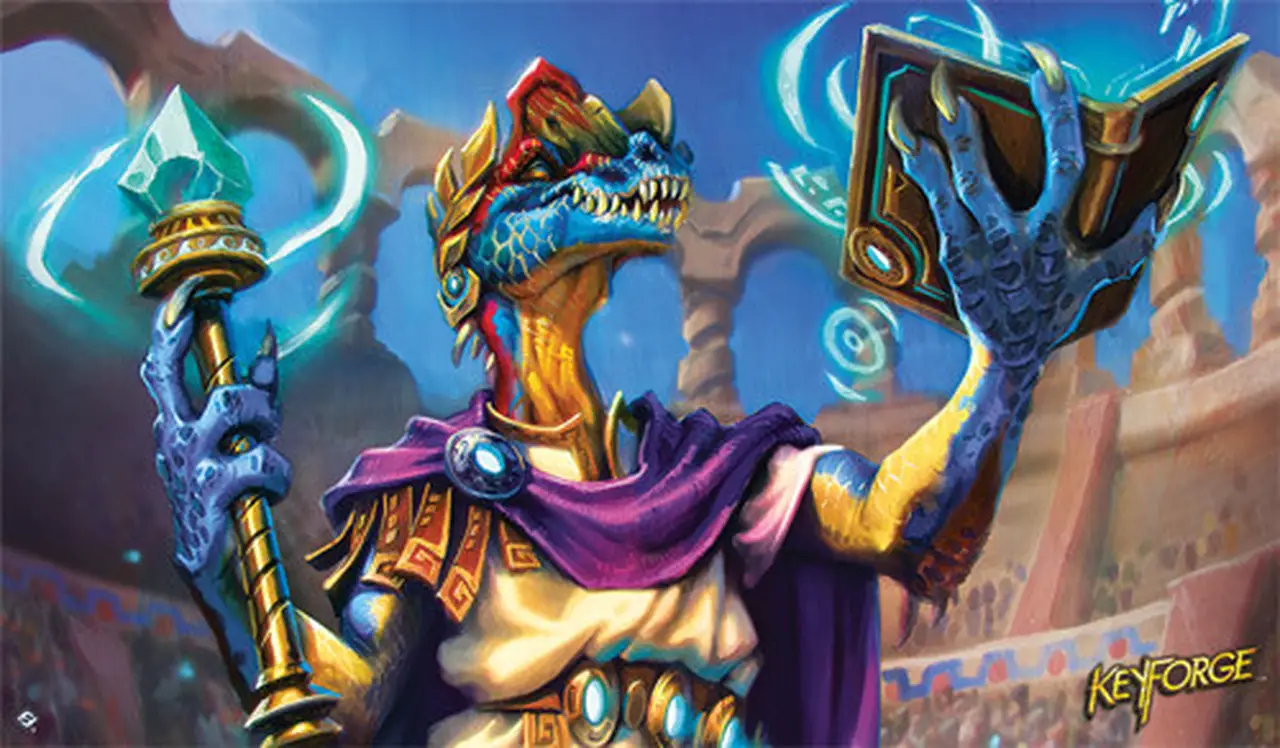It’s fitting that in the month of February, during which we celebrate the birth of the father of evolutionary theory, Charles Darwin, the buzz of the collectible card game world is around something called “Mass Mutations.” The just-announced fourth set in the first ever “unique deck game,” Keyforge, debuts in May with a story that sees a dark version of the mysterious “aember” substance changing the creatures of the Crucible, the composite planet on which they fight for supremacy.
Of course, that’s not how evolution actually works — it’s mutations in the gametes (the sperm and the ova) that start to create new species; changes to an adult organism itself aren’t passed on. It’s all in good fun, though, and the brains behind Keyforge clearly understand this. After all, the lead designer has a degree in paleontology.

That’s right, Brad Andres, the mastermind of this crazy, ever-changing world, already knew a thing or two about descent with modification. His gushing over getting the chance to correct Jurassic Park‘s terribly inaccurate Dilophosaurus on a Fanstasy Flight Games livecast was enough to tip anyone off.
But there’s another, more subtle card in the current “Worlds Collide” set that’s an even better tip-off, and a great Easter egg for people who really know their stuff.
“Worlds Collide,” which, yes, brought in a group of evolved, philosophy-loving dinosaurs, also introduced anomalies, representing cards from future sets that had jumped the gun a bit and turned up in the present. One of those appears to be a giant fish monster, with the name “Valoocanth.”
This is reminiscent of a fish called the coelacanth, native to waters off the southern and eastern coasts of Africa. The coelacanth is a very old animal that hasn’t changed much since its first appearance in the fossil record, a staggering 400 million years ago. It’s actually more closely related to us than it is to most other fish, causing some to consider it a “transitional” form between sea and land animals.

The coelacanth was gone from the fossil record around the same time as the dinosaurs disappeared, 66 million years ago, so the fish was rightfully considered long-extinct during the early days of paleontology. That is until December of 1938, when museum curator Marjorie Courtenay-Latimer noticed one in the catch of a fisherman in South Africa! The local population had known all about it, cursing when the deep water fish was occasionally brought up in their nets, as it tasted bad and can even make people sick when eaten.
The re-discovery of the coelacanth is sometimes used as ammunition by cryptozoologists, people who search for “hidden animals” like Bigfoot and the Loch Ness Monster. If this thing could escape detection for so long, why can’t Bigfoot?!
For starters, remember the coelacanth lives in deep waters. It also hides in caves during the day and only comes out to feed at night. The gorilla, a giant animal that lives on land, wasn’t even discovered by westerners until 1902, a mere 26 years before the coelacanth. A century plus later, you’d hope we know a little more about the Pacific northwest now than we did about deepest Africa then.
Which isn’t to say that new mammals don’t still get discovered today. It’s just usually not by people plunging into unexplored terrain or novel environments. It’s by people like Marjorie Courtenay-Latimer.
Consider the 2013 discovery of the South American olinguito, a two-pound, tree-dwelling raccoon relative native to the Andes mountains, and the first new, carnivorous mammal in the western hemisphere to be described in 35 years. It wasn’t noticed in the field, but in the Smithsonian National Museum of Natural History, by curator of mammals Kristofer Helgen. He observed that several historical specimens of olingo, a larger but very similar animal, had different morphology, and later DNA testing identified the olinguito as a separate species, one that had literally been hiding under our noses.

The coelacanth!
Once Helgen and a field team deployed to the high altitudes of Ecuador (where many of the anomalous pelts had come from), they did indeed identify some living olinguitos — on the very first night they looked. Makes you wonder what Finding Bigfoot did with those 100 episodes.
Every February, to help celebrate Darwin Day, the Science section of AIPT cranks up the critical thinking for SKEPTICISM MONTH! Skepticism is an approach to evaluating claims that emphasizes evidence and applies the tools of science. All month we’ll be highlighting skepticism in pop culture and skepticism of pop culture.
AIPT Science is co-presented by AIPT and the New York City Skeptics.
Join the AIPT Patreon
Want to take our relationship to the next level? Become a patron today to gain access to exclusive perks, such as:
- ❌ Remove all ads on the website
- 💬 Join our Discord community, where we chat about the latest news and releases from everything we cover on AIPT
- 📗 Access to our monthly book club
- 📦 Get a physical trade paperback shipped to you every month
- 💥 And more!













You must be logged in to post a comment.